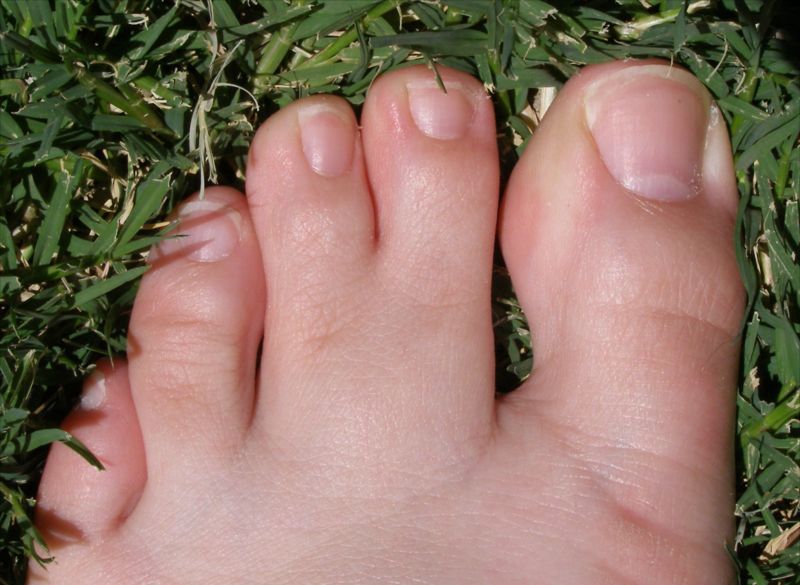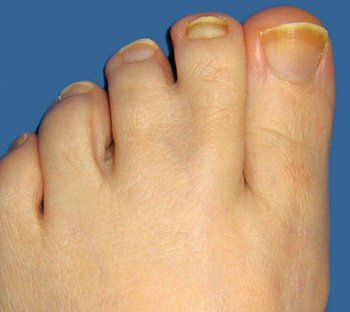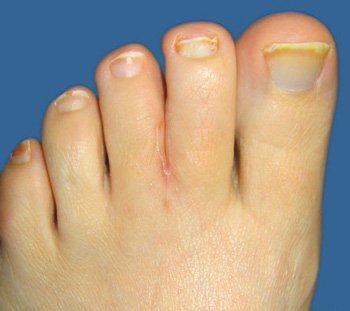Webbed toes
| Webbed toes | |
 | |
|---|---|
| Human foot with partial simple syndactyly. | |
| ICD-10 | Q70.3 |
| ICD-9 | 755.13 |
Template:Search infobox Editor-In-Chief: C. Michael Gibson, M.S., M.D. [1]
Overview
Webbed toes is the common name for syndactyly affecting the feet. It is characterised by the fusion of two or more digits of the feet.
Classification
The scientific name for the condition is syndactyly, although this term covers both webbed fingers and webbed toes. There are various levels of webbing, from partial to complete. Most commonly the second and third toes are webbed or joined by skin and flexible tissue. This can reach either part way up or nearly all the way up the toe.
Pathophysiology
The exact cause of the condition is unknown. In other cases, no other related persons have this condition. Syndactyly occurs when apoptosis or programmed cell death during gestation is absent or incomplete. Webbed toes occur most commonly in the following circumstances:
Associated Conditions
- Syndactyly or Familial syndactyly
- Down syndrome
- Acrocallosal syndrome
- Apert's syndrome
- Aarskog syndrome
- Bardet-Biedl syndrome
- Carpenter's syndrome
- Cornelia de Lange syndrome
- Edwards syndrome
- Jackson-Weiss syndrome
- Fetal hydantoin syndrome
- Miller syndrome
- Pfeiffer syndrome
- Smith-Lemli-Opitz syndrome
- Timothy syndrome
Differentiating Syndactyly from other Disorders
- Syndactyly is having fused or webbed fingers or toes.
- Polydactyly is the presence of more than five digits on the hands or feet.
- Adactyly is the absence of fingers or toes.
Risk Factors
Smoking: Smoking during pregnancy significantly elevates the risk of having a child with excess, webbed or missing fingers and toes, according to the January issue of Plastic and Reconstructive Surgery, the official medical journal of the American Society of Plastic Surgeons (ASPS). In fact, the study found that smoking just half a pack per day increases the risk of having a child born with a toe or finger defect by 29 percent.[1][2]
Epidemiology and Demographics
Webbed fingers or toes occur one in every 2,000 to 2,500 live births and excess fingers or toes occur one in every 600 live births.
Gender
Webbed fingers or toes occur twice as often in boys.
Race
Webbed toes are more common in Caucasians than African Americans. Excess digits, however, are 10 times more common in African Americans.
Natural History, Complications, and Prognosis
Webbed toes is a purely cosmetic condition. This condition does not impair the ability to perform any activity including walking, running, or swimming. There is no evidence that it improves swimming ability. Webbed toes can interfere with the ability to wear toe rings and toe socks.
People with webbed toes may have a slight disadvantage for activities that benefit from prehensile toes.
Psychological stress may arise from the fear of negative reactions to this condition from people who do not have webbed toes. This may lead some individuals to become extremely self-conscious about their feet and go to great lengths to hide them. They may avoid open-toed footwear and activities such as swimming where their feet may be seen. In reality, other people rarely notice this condition unless the person with this condition makes a deliberate effort to point it out.
Diagnosis
This condition is normally discovered at birth. If other symptoms are present, a specific syndrome may be indicated. Diagnosis of a specific syndrome is based on a family history, medical history, and a physical exam.
Family History
In some cases, close family members may share this condition.
Surgery
Webbed toes can be separated through surgery. Surgical separation of webbed toes is an example of body modification.
As with any form of surgery, there are risks of complications.
The end results depend on the extent of the webbing and underlying bone structure.
Complications
- Scarring: There is usually some degree of scarring, and skin grafts may be required.
- Loss of sensation: In rare instances, nerve damage may lead to loss of feeling in the toes.
- Recurrence: There are also reports of partial web grow-back. The skin grafts needed to fill in the space between the toes can lead to additional scars in the places where the skin is removed.
- Bleeding
- Hyperpigmentation of skin graft
References
- ↑ Journal of the American Society of Plastic Surgeons. Li-Xing Man, M.Sc.; Benjamin Chang, M.D. "Maternal Cigarette Smoking during Pregnancy Increases the Risk of Having a Child with a Congenital Digital Anomaly." January 2006, pg. 301.
- ↑ Journal website

